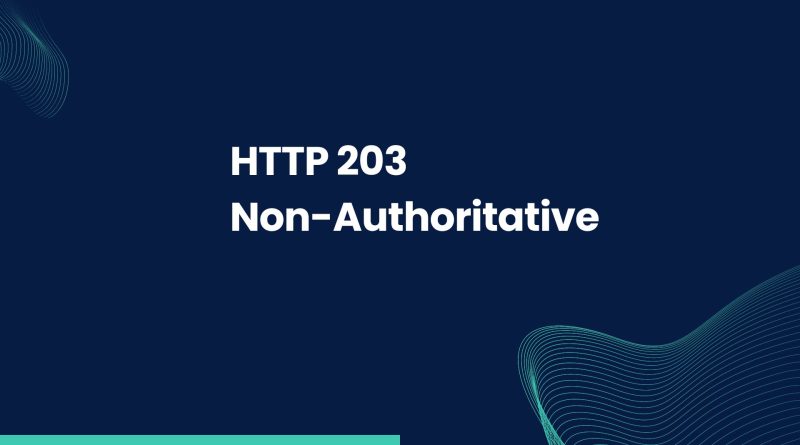HTTP 203 Non-Authoritative: Why You Should Know About It
In today’s digital world and web development, having a comprehensive understanding of web protocols is essential. But many beginners in the tech field tend to overlook HTTP 203: an important status code that can have major implications for your website or application if it’s not taken into consideration. Despite how useful it could be to understand this protocol, you may think it’s too complicated and time-consuming – but don’t worry! In this article, we will break down what HTTP 203 is and why you should care about it so you can quickly get up to speed on the topic.
HTTP stands for Hypertext Transfer Protocol; its purpose is to establish communication between a client (usually a browser) and a server. When there is successful communication established between these two entities, an HTTP status code is received by the client with information regarding whether the request was successful or not. One such status code is “203 Non-Authoritative Information,” which indicates that while the requested resource exists on another server, the user agent should refer to other sources instead of just relying upon the response given from the original source.
It’s no surprise that having knowledge of HTTP codes like 203 can help ensure the smooth functioning of your online services – yet many developers are unaware of their existence or function. If you want to learn more about status code 203 and gain insight into why knowing about it matters, read on!
What Are The Http Statuses?
As I was scrolling through the web searching for answers, I stumbled across a question about HTTP statuses. A query that has been asked countless times by developers and techies alike: What are the HTTP statuses? How do they work? What does each signify? Coincidentally, this is exactly what I had been looking for!
HTTP it’s a system of communication used to request data from servers. Each status code communicates an actionable response back to the user based on their requests. From 200 OK which indicates success to 500 Internal Server Error indicating an issue with the server, there are dozens of codes available in between.
So why should you know about it? Well, understanding how these codes can affect your website or application is essential when building out systems or troubleshooting issues. The 203 status specifically informs users that while the information being sent is accurate, its source isn’t authoritative enough to guarantee accuracy. It may sound confusing at first but having a basic understanding of all HTTP statuses will be incredibly helpful in any development project you take on.
What Is The HTTP 203?
HTTP 203 (Non-Authoritative Information) is a successful HTTP status code that indicates that the request was successful but the information returned by the server may not be the exact representation of the requested resource. Unlike a 200 OK response, which indicates that the information is an authoritative representation, a 203 warning code says that the returned content is only a representation and not necessarily an authoritative representation.
Example
Here is an advanced example of a client-server interaction using the HTTP code 203 Non-Authoritative Information status code:
Client:
GET /my_resource HTTP/1.1
Host: www.example.com
User-Agent: MyClient/1.0
Server:
HTTP/1.1 203 Non-Authoritative Information
Cache-Control: no-store
Date: Tue, 01 Feb 2023 12:00:00 GMT
Server: MyServer/1.0
Content-Type: text/plain
Content-Length: 40
This is not the authoritative representation of the resource.
In this example, the client is making a GET request for the resource /my_resource on the host www.example.com. The server responds with a 203 Non-Authoritative Information status code, indicating that the information being returned is not authoritative and that the client should make a new request to the origin server for the authoritative representation of the resource. The response also includes several headers to provide additional information about the response, including a Cache-Control the header that indicates that the response should not be stored by caches, a Date header with the date and time that the response was generated, and a Server header with information about the server that generated the response.
Other Similar Http Status Codes To 203 Status Code
It’s important to understand the nuances of different HTTP status codes, and 203 is no exception. To get a full picture, it’s helpful to look at other similar codes as well. When looking for alternatives to the 203 Status Code, there are several that come to mind right off the bat.
The 200 OK code indicates successful communication between the client and server; in contrast, the 204 No Content response signals that the request was received by the server but doesn’t contain any content or data. Next up we have 206 Partial Content—this one tells clients that only part of the requested resource has been sent back from the server. Finally, we have 202 Accepted which informs users that their request has been accepted by a server but hasn’t yet been processed further.
All four of these codes provide useful information about how requests are being handled on either end and can be used in tandem with 203 status responses depending on what works best for your application or web page. Knowing which responses you should use when can save time (and headaches) down the road!
Frequently Asked Questions
What Is The Purpose Of The Http 203 Status Code?
The HTTP 203 Non-Authoritative Information status code indicates that the requested resource has been successfully obtained, but the information returned is not authoritative. This status code is typically used in situations where a cache has received a valid response from a source other than the original server, and the response may be a stale or otherwise inaccurate representation of the target resource. The client requests should be made directly to the origin server to get the authoritative representation of the resource.
What Are The Implications Of Using The Http 203 Status Code?
Using the status code 203 Non-Authoritative Information status code has the following implications:
- Indicates that the information returned needs to be more authoritative: The client should not rely on the information provided in the response as it may be stale or otherwise inaccurate.
- May be cached: The response may be cached by intermediate caches and clients, but the information should not be considered reliable unless verified with the original source.
- Encourages clients to make a new request: The client should make a new request directly to the origin server to get the authoritative representation of the resource.
- Can reduce server load: By returning a 203 status code, the server can reduce the load on its resources and avoid sending unneeded data.
- Improved performance: Using a 203 status code can help improve the web application’s performance by reducing the amount of data that needs to be sent over the network.
All HTTP status codes by categories
Informational responses
(100 – 199)



